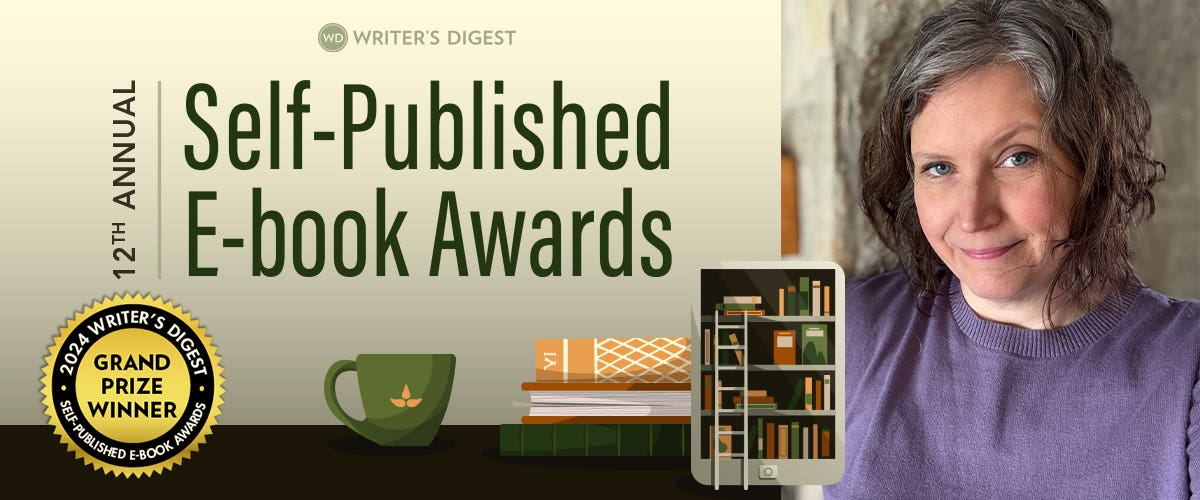7th Annual Pop Fiction Writing Competition Winner: Crime
Here’s the winning entry for the Crime category for the 7th Annual Writer’s Digest Popular Fiction Writing competition by writer/editor Geoffrey C. Fuller.
Here's the winning entry for the Crime category for the 7th Annual Writer's Digest Popular Fiction Writing competition by writer/editor Geoffrey C. Fuller.
Figure-Ground: Proof and Circumstance
I had a terrific, almost instinctive sense of another presence.
The night around us was full of that feeling, shaky with that awareness,
the grass and bushes and trees down the slope almost crackling with it.
When I looked into the dark woods, I saw something moving through them.
—Chuck Kinder, “The Ghosts of the Headless Coeds”
Although retired and in his late 70s, Lt. Col. Nicholas Vance of the West Virginia State Police has command presence. I noted it when we first met, in 2006, and even after all that’s happened, I still sense it: He moves deliberately, not with the tentative uncertainty of age but like someone alert for the unexpected, and speaks quietly, with no wasted words. The voice of authority, a man to whom attention is paid. But his speech also has a rising lilt, as if a question or a tacit invitation to speak, a habit common to people raised in the southern West Virginia coalfields and perhaps cultivated during his years interviewing witnesses and suspects.
“Do you know the coed murders?” he asked me after class the first evening. He and twelve others were taking my course on how to turn memories into books.
“Mared Malarik and Karen Ferrell. Yes.” I don’t remember how the topic came up, but I hadn’t thought about the case for a long time. The murders accounted for my earliest memories of a darkness that is more than the lack of light. When I was growing up in Morgantown, West Virginia, in 1970, two WVU freshmen disappeared while hitchhiking back to their dorm after a movie. Their headless bodies were found three months later in the woods south of town, covered with leaves and sticks, stones from a nearby stream. The two murders, apparently random and occurring at the end of the 1960s when the light of America seemed to be dimming, remained unsolved until six years later, when Eugene Paul Clawson confessed from his prison cell in New Jersey.
“I testified at the trial.” Nicholas watched me as he spoke. “Clawson didn’t do it, you know. Social verdict.”
I nodded as though I’d heard the term before. I supposed he meant that Eugene Paul Clawson was wrongly convicted because the crime had been so terrifying society needed someone to blame. Many people still believe that, including me. Clawson was serving two life sentences at Mount Olive Correctional Complex anyway.
Six months later, long after the writing course was finished, Nicholas called to tell me he had something to discuss.
* * *
I was standing on the porch, looking down our sloping front yard as Nicholas parked his beige Cutlass. He removed a briefcase from his trunk and strode up our steep drive. Taller than me, maybe 6’2” or 6’3”, he must have cut quite a figure back in the day.
“Come on in.”
He set his briefcase on our dining room table and snapped the latches. He seemed more confidant than he had in class. All business, no nonsense.
“I wanted to talk to you about the coeds.” Again, no wasted words. “I know who killed them. I wanted to write a book, but after taking your class, I know I can’t. I think you might be the one to write it.”
I thought, Not the best endorsement of my teaching skills, but quickly moved to what I really wanted to know: “Who killed them?”
He took out two large files and placed them on the table.
“I want to see if you see it. These are state police reports.” He snapped his briefcase shut and stood. “Call me.”
I was excited about the possibility Nicholas had solved the case that had shadowed my life and thrilled to get a chance at real police reports, but I wonder now if at the moment I wasn’t like a future junkie getting his first, free spike.
* * *
The reports absorbed me. So many facts, interviews, citizen tips: Contrary to what the public thought, the police didn’t have too few suspects, they had too many. No way I would have determined who Nicholas suspected if he hadn’t scrawled in a margin, “Alibiing behavior.”
One victim, Mared, had a dental appointment the Monday after she disappeared. When she didn’t show, the dentist called her dorm and her roommate answered the pay phone in the hall. Nicholas was suspicious of the dentist himself calling: “An appointment doesn’t show, the secretary calls.” Elsewhere in the same report a woman alleged the dentist had molested her in his office. And before the bodies were found, the dentist was quoted in the newspaper as saying Mared had an unfinished root canal and would be looking for dental work. From all this, Nicholas inferred the dentist was trying to create an alibi and attempting to inject himself into the investigation, both signs of guilt.
He heard from several people that the man was known for hot-headed arrogance and was a serial philanderer who had dumped his first wife for his dental assistant. “And get this,” Nicholas told me. “He used to drive around town, trying to pick up hitchhiking coeds.”
Nicholas believed he’d cracked the case.
While he was trying to determine the current whereabouts of the dentist—apparently now diagnosed with Alzheimer’s—I was still absorbed by the reports and eagerly accepted more. Among the papers he gave me were Clawson’s original confessions and reports of his psychiatric evaluations. Reading through them over and over, I was struck by the fact that so much could be seen as evidence of guilt—but then, looked at another way, it could be seen as evidence of innocence. Like a figure-ground illusion that flips back and forth: Looked at one way the drawing shows a lamp, but look again and it’s the profiles of two people facing each other; this one is a sketch of a big-nosed old lady—now it’s a young beauty in a fur coat.
Flip: Clawson guilty. Flip: Clawson not guilty.
While Nicholas dug for solid evidence of the dentist’s guilt, I focused on Clawson. Small, circumstantial facts pointed toward his guilt. January 18, the night the coeds went missing, was Clawson’s birthday. A month and a half earlier, his girlfriend had broken up with him. Together, those could have been the stressor that police psychologists call a precipitating event, pushing him toward crime.
Whether he was guilty or not, I learned that his imprisonment was not a tragedy: He “confessed” after he’d already been convicted of several sexual crimes against minors—Clawson was dangerous and belonged in prison.
Finally, though, I decided I’d been right all along. Clawson did not kill the coeds.
What persuaded me was the lurid “true crime” magazine Clawson had in his prison cell. The December, 1969, issue of Detective Cases featured an article entitled “The Case of the Headless Coeds.” Every detail in Clawson’s January, 1970, “confession” appeared in that article; nothing in his confession was not in the article. Six facts in the “confession” and in the article were true, while seven facts cited by Clawson, identical to the article’s “facts,” were not true. In other words, Clawson’s confession precisely mirrored the magazine article, even where the article got the facts wrong.
Flip: Clawson, not guilty. I couldn’t be certain, but I was beyond reasonable doubt. If I’d been on the jury, I would never have voted to convict.
* * *
Nicholas, meanwhile, had located the dentist, who’d been moved from nursing home to nursing home, four times. “Because he’s trouble,” Nicholas told me. “Maybe fights, maybe worse.” I didn’t ask how he knew this, but he seemed sure, even though I was beginning to doubt. An arrogant man with a bad temper might cheat on his wife. He might drive around looking to pick up hitchhiking coeds. He might even molest women. That didn’t mean he killed them.
Nicholas, though, seemed to have no doubts. He was still sure the dentist killed the coeds; he was like a bulldog whose jaws clamp down and refuse to let go.
I was beginning to understand the major differences between investigation and legal determination of guilt. Investigators get hints, follow hunches. Like writers, investigators create stories about how things could have happened. Their imagination fills in blanks as they look for evidence. But the legal system requires proof. As the dentist’s trail cooled, it was easier to see Nicholas’s circumstantial evidence did not constitute proof.
* * *
In an attempt to revitalize the investigation, Nicholas secured an invitation to appear on Talkline, a statewide radio show hosted by Hoppy Kercheval, one of the deans of West Virginia’s social and political chatter. On October 6, 2006, he was to talk about his investigations, and Hoppy called me a day or so before. One of the things he asked—and he was very delicate about this—was whether Nicholas was compos mentis. The man was nearing 80 after all. Was he in full possession of his faculties?
“No question,” I assured him. “He’s sharp. He knows what he’s doing.”
Nicholas was on the show for one segment, one ten-minute period between commercials. Toward the end, when asked about the chances of solving the crime after all these years, Nicholas said, “The odds are not very good, really. But there’s somebody out there who can help me. If they just come forward, we can get it done.”
The next day, Nicholas got the call about the machete. The caller lived in the same house she had as a child. She’d been playing catch in the summer of 1970 when the ball rolled down the hill into a storm drain. Fishing it out, she’d found a machete that her mother promptly put in the attic. Nicholas could have it if he wanted it.
The instrument used to decapitate the coeds had never been found.
After meeting with Nicholas and hearing about his investigation, the state police accepted the machete as possible new evidence. For the first time since the West Virginia State Police began, in 1919, a closed case for which someone had already been convicted was reopened.
* * *
Meanwhile, I was increasingly addicted to the 3500 pages of police reports and trial testimony, the chance to follow an actual trained investigator. Now an insider, I was surprised to discover how much of what was “known” about the crime by the public was, and is, completely false. Neither Mared nor Karen was raped or sexually abused. No indication of a ritual component to the crimes exists, despite the widespread belief the coeds were killed by Satanists. Even their ages were wrong. Every newspaper said they were both 19, as did police reports, despite listing their dates of birth in the same paragraph as their ages. While Mared was 19, Karen was 18. Her 19th birthday would have been four days after her body was discovered.
Nicholas never did find anything that proved the dentist did or didn’t kill the coeds, but by mining old reports, taking phoned-in tips, and talking with former colleagues he began to locate other persons of interest. For four years, Nicholas followed up on more details and suspects than I have room to discuss here. Each time, the new person of interest looked more likely than the previous one. Another way real investigations differ from TV dramas—suspects are rarely ruled out so much as others gradually appear more likely:
• a man arrested for trying to saw the head off a female stranger in nearby Maryland;
• a man who dragged his girlfriend to a water well and threatened to “cut [her] head off and throw it down there with the heads of those goddamned girls”;
• a man who could have been one of America’s earliest and longest-active serial killers;
• a man with whom Maxine Massey had sat in a car as his talk grew increasingly disconnected and obsessively concerned with how soft her fur coat looked.
Each of these suspects and many more looked like possibilities. As I watched him track down leads and interview people, I began to equate him with Walt Kowalski, Clint Eastwood’s character in Gran Torino, the tough man in the twilight of his years, fighting one last good fight. What I didn’t notice until later, looking back, was that Nicholas seemed increasingly reluctant to let go of a suspect.
Then Nicholas got another call from a man with a story. He’d grown up near where the coeds’ bodies were found, and his parents used to send him to fetch fresh eggs from a nearby farm. Except they wouldn’t allow him to go when a certain young man, Eddie, was the only person home. Eddie was trouble, used to regularly beat area kids. Our informant told us Eddie was known for “torturing animals.” I asked what that meant, exactly. “He pulled the legs off cats.”
Nicholas and I looked at each other, and Nicholas asked, “Do you know where this Eddie is currently?”
* * *
As we drove to the assisted-living home, Nicholas and I discussed something else we’d learned: Eddie was the uncle of a man police suspected in 1970; he lived in the same house, and the police never knew it. Ronnie had been a janitor in Westchester Hall, home of Mared and Karen. He was the man Maxine Massey sat with, the man of the strange talk and the fur fetish.
Karen’s fur coat had never been found; neither had Mared’s fur-lined boots.
When we arrived at the assisted-living home and went up to Eddie’s room, we discovered he was in a wheelchair. A large man, overweight with the fat of a former athlete, he would have stood much taller than either of us.
“What can I do for you?” Eddie motioned us in. He was dark haired and clean cut, roughly matching the witnesses’ description of the driver who picked up Mared and Karen. Eddie was plainly wondering who had come to visit him. And why.
“Nicholas Vance.” Nicholas held out his badge for Eddie to see. The badge was one issued to retired state troopers, but Nicholas’s thumb covered the word retired.
I stood to one side of Eddie, about six feet away, across from Nicholas. You never know.
“We’re looking into an old case,” Nicholas said, soft and avuncular. “Old and dusty. We’re wondering if you could help us with it. The coed murders. Back in 1970.”
“Don’t know nothing about that,” Eddie said, rather quickly. He continued to look back and forth from Nicholas to me.
“We’re talking to people who used to live in the area,” Nicholas said in his unassuming manner. “People off the Grafton Road.”
“I don’t know nothing about it,” Eddie said, the repetition sounding alarm bells. “Just what I read in the papers.”
The idea that a man who lived less than a mile from where two decapitated bodies were found wouldn’t know anything about it stretched credulity. People talk, and rural people talk a lot about things happening in their neck of the woods.
Nicholas said, “We’re just trying to find out if anyone from that time might know something. Someone who might have done it maybe.”
This approach elicited similar responses every time either of us brought it up: hesitation followed by real or feigned thought, and then a name. Sometimes two.
Eddie named at least a dozen people, rapidly.
Nicholas threw out a few more general questions, trying to get the measure of the man. Throughout the interview, Eddie repeated every question, a common stalling tactic of people who are not being frank. I was on Eddie’s mind, his eyes flickering toward me often. Still, Nicholas succeeded in lulling Eddie with his aww-shucks approach. Eddie was getting more relaxed, positively jovial, until Nicholas asked, “What kind of car did you drive back then, Eddie?”
Eddie’s demeanor immediately turned brittle and cold.
“Why do you want to know that for?” His voice low, pitched with menace.
“Just nosey, I guess,” Nicholas said casually.
“That nose of yours gonna get you in trouble,” Eddie said. “We’re done.”
“Okay,” Nicholas said after a second. “Guess we should go. Didn’t mean to offend you, Eddie.”
“You didn’t offend me. Just sticking your nose where it don’t belong.”
Nicholas and I left, but on the way down the hall to the elevator, I said, “That’s our boy,” and Nicholas muttered only, “May be.”
I didn’t know it at the time, but he had one more person he wanted to check.
* * *
Alphonse Michael Estep majored in aerospace engineering at WVU in the late 1960s. He did well, but after a couple of years, his grades began to fall. He got in fights. He dumped one girlfriend, nearly naked, on the steps of her sorority house; less than a year later, married to another woman, he had a fight with her and ended up stabbing a large knife into the ground outside their trailer before he tried to burn it down. She was frightened and later complained to police that he cleaned a pistol in front of her in a “threatening manner.”
Estep swerved between mania and depression, but what interested Nicholas most was Estep’s membership in a fraternity, which had a house machete last seen in the trunk of Estep’s car. Most important, Nicholas told me that several fraternity brothers, and some other students, reported that Estep wrote a story in the fall of 1969 in which two girls were decapitated.
Nicholas was convinced Estep was the man, and the more he looked, the harder his bulldog jaws locked. He talked with Estep’s by-then ex-wife a number of times. He sent Estep letters, none of which were ever answered. He uncovered a history of hospitalizations, broken relationships, dislocation. Estep moved between West Virginia, North Carolina, and Ohio. Nicholas saw this as the desperate wanderings of the guilty. I did, too, sometimes. Other times, I saw the movements of a man whose life had been shattered by mental illness.
Flip: He’s obsessed and guilty, running from a dark past. Flip: He’s wrenched by illness, always conscious of the successful aerospace engineer he could have been.
In the winter of 2009, Nicholas finally succeeded in talking a West Virginia cold case investigator and an Ohio Bureau of Investigation detective into visiting Estep for an hour-long discussion. That discussion was recorded.
* * *
About this time, I was reading Whoever Fights Monsters, by Robert Ressler, one of the seminal figures of the FBI’s behavioral science unit. Toward the end I came to his account of John Brennan Crutchley, a man convicted of picking up a hitchhiker in Florida and bleeding her for three days as he raped her. She managed to escape and brought the police down on him. Searching the Crutchley home, Ressler became convinced Crutchley was not just the Vampire Rapist but a serial killer.
They found 72 index cards with women’s names on them and almost 30 credit and ID cards from women who they later learned were missing. A handful of women’s necklaces hung in a closet; one of the items missing from Karen’s body had been a necklace with her high school class ring on it.
Crutchley was 24 in 1970. He’d grown up in Pittsburgh and would have traveled through Morgantown and down Route 119 on his way to visit his mother in Bridgeport, West Virginia. Much of the evidence from the coed murders had been found along Route 119. Subsequent investigations tied Crutchley circumstantially to women’s bodies found in Florida and Maryland. His earliest presumed victims were found in southwestern Pennsylvania, just over the border from Morgantown. Covered with leaves, sticks, and stones from nearby streams.
Excited, I asked Nicholas to call the Brevard County Sheriff’s office, where the Crutchley evidence had been stored since his death in prison in 2002. I wanted Nicholas to ask about the necklaces, to learn whether one of them had a class ring from Greenbrier West High School.
He refused: “We found our guy.”
His denial was, I believe, the beginning of our falling out.
* * *
Nicholas would not consider Crutchley, even briefly. “We found our guy,” he kept saying. “We don’t need to look any further.”
But when I listened to the recording of the Estep interview, I heard a man baffled by why police would be talking to him about something that happened 40 years earlier. He insisted he hadn’t written anything about decapitating women, and I pointed out to Nicholas that the paper—or story—was reported variously as having been about Estep being decapitated, about a fight between two women who stabbed each other, or about a gunfight he’d had with two men.
I began to think about other assertions Nicholas made over the years. Some of them varied from the police reports, but I’d assumed he had inside information. Others seemed to change over time to fit new narratives. Much of what he said, I had no direct knowledge of and had relied on his accuracy. I began to doubt the investigation I’d been shadowing. I realized I’d been looking at Nicholas as the solid ground on which the investigation proceeded, but he was becoming a figure that moved against a shifting background.
I told him I had reservations about writing a book that pointed definitively at Estep.
“Don’t do a book at all, then,” he said. “I could give a damn.”
He meant it, said he’d copyrighted all the police reports, said he’d sue me if I wrote about anything he’d ever said. His assertions were becoming increasingly bizarre: He couldn’t copyright police records or dictate what I wrote about. I had no idea where this was coming from.
* * *
“I made you a writer,” he said over the phone one of the last times we talked. “I made your career.”
I didn’t know what to say. I could have reminded him we met in a writing course I was teaching. I could have simply said he was delusional. I began to dwell on his age, something I hadn’t thought about the entire time I knew him. I suspected his ability to intuit the story behind the facts now overwhelmed his grasp of the facts. But I couldn’t be sure.
I’d experienced the ultimate figure-ground reversal, the whole enterprise shifted from exhilarating to weighted and laced with gloom. Just like the suspects, who flipped from plausible to unlikely in the blink of an eye, the indefatigable investigator I had admired for several years, stories of whose halcyon days I’d heard both from him and from other state troopers, whose toughness and intelligence took him to nearly the highest rank possible for a state trooper, stopped being Walt Kowalski and became in my eyes, at least partially, Don Quixote.
The thought saddened me. Growing up, the coed case had represented all that was dark and unknowable about the world, the sudden and violent end of two young lives, a crime both heinous and apparently pointless, no perpetrator ever found. Then, unexpectedly, I’d been on the inside, watching a dedicated investigator search for the actual perpetrator. I admired and respected him; the case had been part of my life for five years. At times I’d believed that the mystery would be solved and meaning restored.
But in the end, no proof had been found, either about the perpetrator or about whether I’d been shadowing Kowalski or Quixote. I suspected that, like figure-ground illusions, both men had been there all along. The mystery of who killed the coeds had become tinged with other mysteries, of proof and circumstance, of age and the attenuation that we all face eventually. I was left with nothing definitive but melancholy and the memory of repeated visits to a gravesite remote and desolate, where I looked into those dark woods and thought I saw something moving through them.
I’ll never be sure what I saw.








